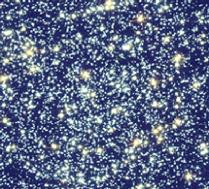(Clearwisdom.net) Simulated stars collide near the core of a globular cluster, forming a strange "blue straggler."
Recently, astronomers discovered a great number of surprising phenomena in the vast universe. These observations indicate that violent changes are taking place in our universe. At the beginning of 2003, Science magazine devoted a special issue to introduce the tremendous changes occurring in the Milky Way's globular cluster.
Globular clusters are believed to be among the oldest stellar systems. Thus, an accurate determination of the age of the oldest clusters can yield lower limits on the age of the universe. Many breathtaking upheavals have been discovered through observing the galaxies' globular clusters. Astrophysicists pointed out that the night sky would look spectacular from a planet near the core of a globular cluster, one of the Milky Way's compact swarms of stars. Professor Robert Irion's article, "The Milky Way's Restless Swarms of Stars" introduced the spectacular phenomena observed in the Milky Way's globular clusters: Globular cluster 47 Tucanae seen from the ground (left) and space (right), has spawned dozens of millisecond pulsars. [Source: NASA]
Instead of the paltry few stars we see within several light-years of our sun, cluster aliens would face a vista of 100,000 stars or more. Stars in the hearts of globular clusters interact so closely and so frequently, in astronomical terms, that planetary systems can't survive the chaos. Indeed, stars themselves are not immune. Many get banished to the cluster's outskirts or ejected into deep space after intense gravitational encounters. Some stars even collide, making bizarre new objects that are at least a billion times more likely to arise in globular clusters than elsewhere in the galaxy. Astronomers would have crisp views of binary partners that whip around each other in hours or minutes, pulsars that spin nearly 1000 times every second, and perhaps a nest of neutron stars or the event horizon of a sizable black hole at the center of it all. The Milky Way's 150 known globular clusters live within the galaxy's halo, a sparsely populated sphere of old stars that cocoons the disk and central bulge. They dart on vast swooping orbits; a time-lapse simulation of clusters in motion creates the impression of moths fluttering around a street lamp.
Detailed surveys by both Hubble Space Telescope (HST) and Chandra X-ray Observatory as well as computer simulations reveals that the dynamics of the cluster and the evolution of its stars are inextricably linked. Stars are so close that any changes in their mass or size influence how they interact with neighbors.
The pot's most critical ingredients are binary stars. Scientists draw a parallel between heating a gas and exciting the stars in a cluster with the motions of its binaries. "The particles in the gas are stars instead of molecules, but it's the same physics," says astrophysicist Frederic Rasio of Northwestern University in Evanston, Illinois. A globular cluster's binary stars respond to the density of the overall cluster. If the cluster is puffed up and stars aren't jammed too close together, there are fewer encounters between binary systems and other stars. But when gravity pulls the cluster together more tightly--as it inexorably does --the close flybys skyrocket. A third star can swing past a binary and, via a complex gravitational dance, gain kinetic energy. That forces the binary stars into a tighter orbit around each other, a process called binary "burning." Such "evaporation," as astronomers call it, is the main threat to a cluster's long-term survival. Moreover, the binary fuel supply runs low as the orbits in each pair grow tighter after repeated interactions. A cluster might last a billion years, 10 billion years, or more, depending on its initial mass and how many binaries it contains.
No one knows how easy it is for binary stars to arise when globular clusters are born. However, calculations show that it doesn't take many of them to affect the cluster's evolution. If just 5% to 10% of a cluster's stars are in binaries, they impart enough "heat" to the rest of the stars to prevent the cluster from imploding on itself. Indeed, just a handful of binary stars can yield more energy than the gravitational energy that binds a whole cluster together. Still, catastrophic collapses do occur. A surprising portion of the Milky Way's globular clusters--as much as 20%, by some reckonings--have undergone "core collapse." Therefore there is a severe conflict between observation and the theoretical prediction. Till now there is still lack of a convincible theory to explain this core collapse.
Globular cluster provides an opportunity for astronomers to study the stellar behavior in a compact state, in which, the unusual star movements remain a mystery to scientists.
Reference: http://www.sciencemag.org/cgi/content/full/299/5603/60






